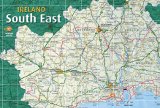South East Ireland Tourism
Travel guide to Ireland's south east
Travel guide to Ireland's south east
Blackwater Valley Scenic Drive
View Blackwater Valley Scenic Drive in a larger map
Dungarvan • Youghal Bridge • Molana Abbey • Glendine Church • Knockanore • Strancally • Lismore • Ballyduff • Tallowbridge • Tallow • Dungarvan •
Follow the road from Dungarvan to Youghal, turning immediately right after the wide-span bridge, near the Co. Cork resort. This road parallels the Blackwater upstream. The first turn, right, leads onto a short narrow laneway beside which is the ruin of the medieval castle of Rhinecrew, built by the Knights Templar, together with an old church or graveyard. The lot is extensively overgrown and should be explored with extreme caution.
Continuing north, some wide brick pillars, right, lead to the estate of Ballynatray House (private). There is access through the estate to the “island” Molana Abbey, now joined to the mainland by a cause way built in 1806 by Grice Smyth, who built Ballynatray House. Visitors are welcome to Molana Abbey on certain days. A monastery was founded here in the 6th century by St. Maelanfaidh and was re-founded for the Canons Regular of St Augustine towards the close of the 12th century. The church contains some fine lancet windows while the Chapter Room is said to be the last resting place of Raymond le Gros, who came with the first wave of Anglo-Norman conquerors and died in 1186. The two-storey building nearby is thought to have been the prior’s lodgings. The statue of the saint founder is of more recent vintage and was placed inside the abbey walls in 1820 by the widow of Grice Smyth.
Ballynatray House was built by the same Grice Smyth in 1795 and incorporates some walls of a much earlier house and medieval castle.
Return to the main road and continue northwards. Glendine Church, signposted left, is worth a visit if only for its grotto-like idyllic setting. A deep, small valley contains the church, some lovely woodlands, a tumbling river and a picturesque cascade, creating the perfect setting for contemplation.
Follow the signs northwards for Knockanore, keeping right at the next two forks and turning right at the next junction, signposted Riann Aluinn (Scenic Route).
The narrow road dips and climbs to a point where a lovely sweep of the Blackwater, its confluence with the Bride River and the glorious backdrop of the Knockmealdown Mountains, suddenly come into view. As the road descends, the gates of Strancally Castle can be seen on the right. This is a private estate owned by the Billensteiner family.
Strancally Castle was designed by James and George Pain and built for John Kelly around 1830. It stands in front of the original ruin of a Desmond castle, which contained an infamous murdering hole, which dispatched those who incurred the wrath of a Desmond to the river below. There is no access to the Desmond castle.
Continue the Drive, passing Headborough House, left, (private) which dates from 1730 and was remodelled in 1830. The road now dips and runs along the valley floor next to the river. Soon Dromana House can be seen across the river, with the 17th century house sitting on top of the old Fitzgerald castle (See Dromana Drive). Shortly after, the road forks, with Lismore signposted left. Our drives take the right fork, passing the gates of Tourin House and Gardens.
The estate was owned by the Roch family in the early 17th century. It then passed to the Nettles and was sold to Richard Musgrave in 1780. The original tower house still stands, attached to which are the remains of an early Georgian E-shaped house. Tourin House was completed in 1840 using stone from the original early Georgian structure. Tourin Gardens are a joy to behold and were originally laid out on the advice of Richard Beamish, a great friend of Sir Richard Musgrave and part owner of the Beamish and Crawford Brewery in Cork. Glorious displays of rare azalea, magnolia and rhododendron varieties delight the eye. Every turn through the wooded paths presents an exciting display of colour against which the mature cedars, evergreens, oaks and woody branches of the tree rhododendrons provide a lovely contrast. This is a spring garden and is at its best from March to May.
Leaving Tourin, turn right at the gates and left at the next junction for Lismore.
Take the Ballyduff road from Lismore, following the golf course signs. This very scenic route offers panoramic views of the Knockmealdowns, which can be appreciated from the village of Ballysaggart. Return to the Lismore road for 1km approx. and turn right to Ballyduff, joining the main Lismore-Ballyduff road. Again the Blackwater shows its charms, etched against the verdant green fields of the valley.
The Booley House is a generic title for an evening of traditional song, dance and storytelling held in St Michael’s Hall, Ballyduff at 20.30 each Wednesday evening in August. Booking through local accommodation units or at Lismore Heritage Centre.
Ballyduff castle on the Lismore-Fermoy road was erected in 1628 by Richard Boyle.
Follow the Tallow road from Ballyduff, crossing the Blackwater. The town can be seen in the valley below long before it is reached by road. Above Tallowbridge on the way to the town is Tallow Hill, a vantage point offering superb panoramic views of the Blackwater Valley on one side and of the Bridge Valley on the other.
Tallow is the birthplace of two John Hogans who died in the same year; one was a poet and weaver (1780-1858) and the other a famous sculptor (1800-1858). In the early 17th century, this area was planted with English settlers by Richard Boyle.
Continue through the town, following the signs for Youghal. The road weaves through constantly changing landscapes of hills, forests and wooded valleys. Then, the panorama of Youghal Bay can be seen ahead before the main N25 road is joined. Turn left for Dungarvan and journey's end.






